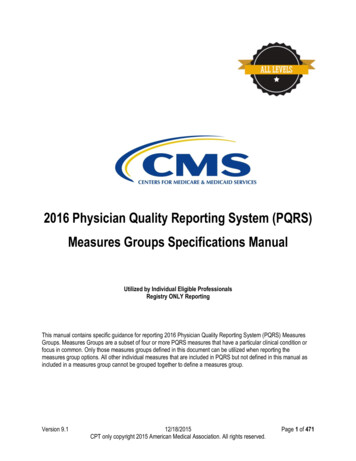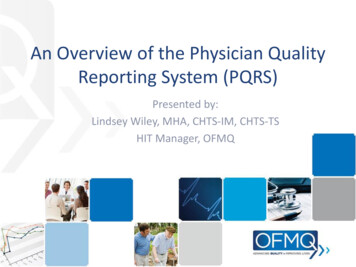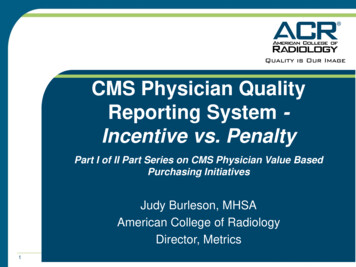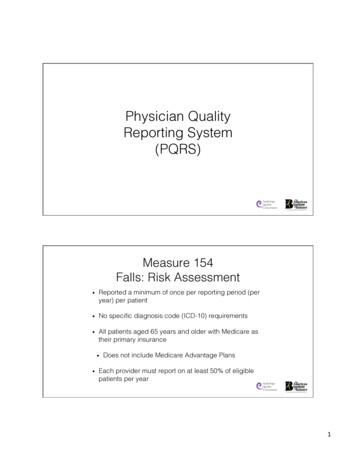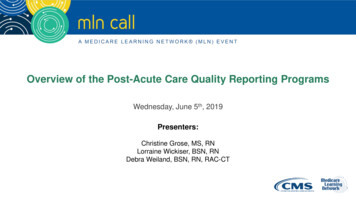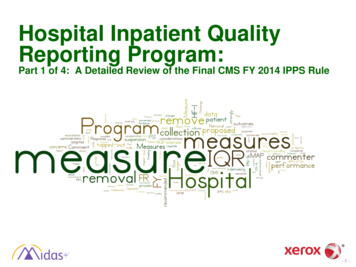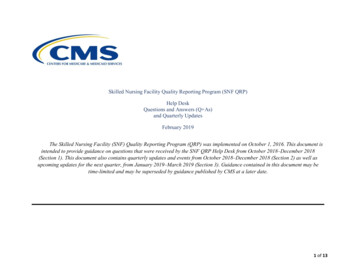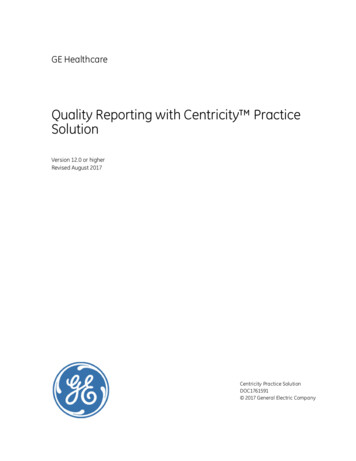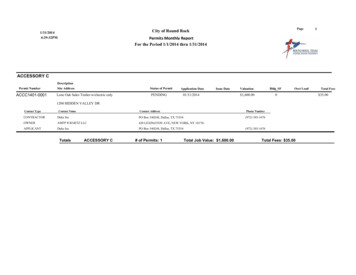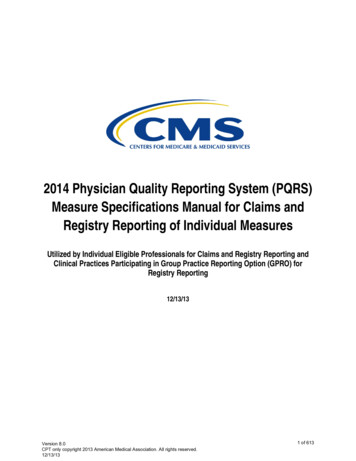
Transcription
2014 Physician Quality Reporting System (PQRS)Measure Specifications Manual for Claims andRegistry Reporting of Individual MeasuresUtilized by Individual Eligible Professionals for Claims and Registry Reporting andClinical Practices Participating in Group Practice Reporting Option (GPRO) forRegistry Reporting12/13/13Version 8.0CPT only copyright 2013 American Medical Association. All rights reserved.12/13/131 of 613
Table of ContentsPQRS IntroductionExample PQRS Measure SpecificationList of 2014 PQRS Measure Numbers, Measure Titles, Reporting Options, and Page NumbersList of Retired PQRS Measure Specifications2014 PQRS Measure Specifications for Claims and Registry ReportingSymbol and Copyright InformationVersion 8.0CPT only copyright 2013 American Medical Association. All rights reserved.12/13/13Page36916206022 of 613
PQRS IntroductionThe measure specifications contained in this manual are intended for individual eligible professionalsreporting via claims or registry and group practices reporting via registry for the 2014 Physician QualityReporting System (PQRS). Measure specifications for measures groups reporting are included in a separate manual, “2014Physician Quality Reporting System Measures Groups Specifications Manual,” which can beaccessed at: l Group practices electing to participate in the PQRS group practice reporting option (GPRO).reporting PQRS via GPRO Web-Interface may access the GPRO Web Interface NarrativeSpecifications at: tient-AssessmentInstruments/PQRS/GPRO Web Interface.html Meaningful Use measure specifications can access electronic clinical quality measures (eCQMs) es.html Information regarding CG-CAHPS may be found outSurveyPlease note that this link is directed to the Accredited Care Organization webpage. There will bea separate PQRS CAHPS webpage available in spring 2014.Each measure is assigned a unique number. Measure numbers for 2014 PQRS represents a continuation innumbering from the 2013 measures. For 2014 PQRS measures that are continuing forward in the 2014PQRS, measure specifications have been updated. In addition to the measure specifications manual, pleaserefer to the “2014 Physician Quality Reporting System Implementation Guide” for additional informationessential in assisting eligible professionals’ understanding and submission of measures. This document canbe accessed at: l.Those who report satisfactorily for the 2014 program year may avoid the 2016 payment adjustment.Additional information on how to avoid future PQRS payment adjustments can be found throughsupporting documentation available on the CMS website: tient-Assessment-Instruments/PQRS/.Eligible ProfessionalsEligible professionals submitting billable services on Part B claims for allowable Medicare Physician FeeSchedule (PFS) charges may report the quality action for selected PQRS quality measure(s). Providers notdefined as eligible professionals in the Tax Relief and Health Care Act of 2006 or the MedicareImprovements for Patients and Providers Act of 2008 are not eligible to participate in PQRS. A list of eligibleprofessionals can be found on the PQRS website at: tientAssessment-Instruments/PQRS/How To Get Started.html.Frequency and Performance TimeframesThe measure instructions limit the frequency of reporting necessary in certain circumstances, such as forpatients with chronic illness for whom a particular process of care is provided only periodically. Eachindividual eligible professional or group practices participating in 2014 PQRS should report according to thefrequency and timeframe listed within each measure specification.Version 8.0CPT only copyright 2013 American Medical Association. All rights reserved.12/13/133 of 613
Denominator Codes (Eligible Cases) and Numerator Quality-Data CodesQuality measures consist of a numerator and a denominator that permit the calculation of the percentage of adefined patient population that receive a particular process of care or achieve a particular outcome. Thedenominator population may be defined by demographic information, certain International Classification ofDiseases, Ninth Revision, Clinical Modification (ICD-9-CM) diagnosis (01/01/2014-9/30/2014), InternationalClassification of Diseases, Tenth Revision, Clinical Modification (ICD-10-CM) diagnosis (10/01/201412/31/2014), Current Procedural Terminology (CPT) and Healthcare Common Procedure Coding System(HCPCS) codes specified in the measure that are submitted by individual eligible professionals as part ofa claim for covered services under the PFS for claims-based reporting. This same criteria is also applied forindividual eligible professsionals and group practices who chose to report via a registry although this data isnot necessarily submitted via a claim.If the specified denominator codes for a measure are not included on the patient’s claim (for the same date ofservice) as submitted by the individual eligible professional, then the patient does not fall into thedenominator population, and the PQRS measure does not apply to the patient. Likewise, if the specifieddenominator codes for a measure are not associated with a patient for an individual eligible professional orgroup practice submitting to a registry, then the patient does not fall into the denominator population, and thePQRS measure does not apply to the patient. Some measure specifications are adapted as needed forimplementation in PQRS in agreement with the measure developer. For example, CPT codes for noncovered services such as preventive visits are not included in the denominator.PQRS measure specifications include specific instructions regarding CPT Category I modifiers, place ofservice codes, and other detailed information. Each eligible professional and group practice shouldcarefully review the measure’s denominator coding to determine whether codes submitted on a given claimor to a registry meet denominator inclusion criteria.If the patient does fall into the denominator population, the applicable Quality Data Codes or QDCs (CPTCategory II codes or G-codes) that define the numerator should be submitted to satisfactorily report qualitydata for a measure for claims based reporting. When a patient falls into the denominator, but the measurespecifications define circumstances in which a patient may be appropriately excluded, CPT Category II codemodifiers such as 1P, 2P and 3P or quality-data codes are available to describe medical, patient, system, orother reasons for performance exclusion. When the performance exclusion does not apply, a measurespecific CPT Category II reporting modifier 8P or quality-data code may be used to indicate that the processof care was not provided for a reason not otherwise specified. Each measure specification provides detailedreporting information. Although a registry may or may not utilize these same QDCs, the numerator clinicalconcepts described for each measure are to be followed when submitting to a registry.G-codes that are are associated with billable charges and found within the denominator, within this reportingprogram, are refered to as HCPCS coding. G-codes that describe clinical outcomes or results and are foundwithin the denominator are generally described as QDC’s.For eligible professionals reporting individually, PQRS measures, including patient-level measure(s), maybe reported for the same patient by multiple eligible professionals practicing under the same TaxIdentification Number (TIN). If a patient sees multiple providers during the reporting period, that patient canbe counted for each individual NPI reporting if the patient encounter(s) meet denominator inclusion. Thefollowing is an example of two provider NPIs (National Provider Identifiers), billing under the same TIN whoare intending to report PQRS Measure #6: Coronary Artery Disease (CAD): Antiplatelet Therapy. ProviderA sees a patient on February 2, 2014 and prescribes an aspirin and reports the appropriate quality-datacode (QDC) for measure #6. Provider B sees the same patient at an encounter on July 16, 2014 andverifies that the patient has been prescribed and is currently taking an aspirin. Provider B must also reportthe appropriate QDCs for the patient at the July encounter to receive credit for reporting measure #6.Version 8.0CPT only copyright 2013 American Medical Association. All rights reserved.12/13/134 of 613
Eligible professionals reporting under a group practice selecting to participate in the PQRS group practicereporting option (GPRO) under the same Tax Identification Number (TIN), should be reporting on the samepatient, when instructed within the chosen measure. For example, if reporting measure #130:Documentation of Current Medications in the Medical Record all eligible professionals under the same TINwould report each denominator eligible instance as instructed by this measure.If the group practice choses a measure that is required to be reported once per reporting period, then thismeasure should be reported at least once during the measure period by at least one eligible professionalunder the TIN. Measure #6: Coronary Artery Disease (CAD): Antiplatelet Therapy is an example of ameasure that would be reported once per reporting period under the TIN.CMS recommends review of any measures that an individual eligible professional or group practice intendto report. Below is an example measure specification that will assist with satisfactorily reporting. Foradditional assistance please contact the QualityNet Help Desk at the following:QualityNet Help Desk – Available Monday – Friday; 7:00 AM–7:00 PM CSTPhone: 1-866-288-8912Email: Qnetsupport@sdps.orgMeasure Specification Format (Refer to the Example Measure Specification Below)Measure titleReporting option available for each measure (claims-based and/or registry)Measure descriptionInstructions on reporting including frequency, timeframes, and applicabilityDenominator statement and codingNumerator statement and coding optionsDefinition(s) of terms where applicableRationale statement for measureClinical recommendations or evidence forming the basis for supporting criteria for the measureThe Rationale and Clinical Recommendation Statements sections provide limited supporting informationregarding the quality actions described in the measure. Please contact the measure owner for sectionreferences and further information regarding the clinical rational and recommendations for the describedquality action. Measure owner contact information is located on the last page of the Measures List document,which can be accessed at: l.CPT only copyright 2013 American Medical Association. All rights reserved. CPT is a registered trademark ofthe American Medical Association. Applicable FARS/DFARS Apply to Government Use. Fee schedules,relative value units, conversion factors and/or related components are not assigned by the AMA, are not partof CPT, and the AMA is not recommending their use. The AMA does not directly or indirectly practicemedicine or dispense medical services. The AMA assumes no liability for data contained or not containedherein.Version 8.0CPT only copyright 2013 American Medical Association. All rights reserved.12/13/135 of 613
Version 8.0CPT only copyright 2013 American Medical Association. All rights reserved.12/13/136 of 613
Version 8.0CPT only copyright 2013 American Medical Association. All rights reserved.12/13/137 of 613
Version 8.0CPT only copyright 2013 American Medical Association. All rights reserved.12/13/138 of 613
List of 2014 PQRS Individual Measure Specifications for Claims and 223242830313233353639404143Measure TitleDiabetes: Hemoglobin A1c Poor ControlDiabetes: Low Density Lipoprotein (LDL-C) Control ( 100 mg/dL)Heart Failure (HF): Angiotensin-Converting Enzyme (ACE) Inhibitor orAngiotensin Receptor Blocker (ARB) Therapy for Left Ventricular SystolicDysfunction (LVSD)Coronary Artery Disease (CAD): Antiplatelet TherapyCoronary Artery Disease (CAD): Beta-Blocker Therapy - Prior MyocardialInfarction (MI) or Left Ventricular Systolic Dysfunction (LVEF 40%)Heart Failure (HF): Beta-Blocker Therapy for Left Ventricular SystolicDysfunction (LVSD)Anti-depressant Medication ManagementPrimary Open-Angle Glaucoma (POAG): Optic Nerve EvaluationAge-Related Macular Degeneration (AMD): Dilated Macular ExaminationDiabetic Retinopathy: Documentation of Presence or Absence of MacularEdema and Level of Severity of RetinopathyDiabetic Retinopathy: Communication with the Physician Managing Ongoing Diabetes CarePerioperative Care: Timing of Prophylactic Parenteral Antibiotic –Ordering PhysicianPerioperative Care: Selection of Prophylactic Antibiotic – First OR SecondGeneration CephalosporinPerioperative Care: Discontinuation of Prophylactic Parenteral Antibiotics(Non-Cardiac Procedures)Perioperative Care: Venous Thromboembolism (VTE) Prophylaxis (WhenIndicated in ALL Patients)Osteoporosis: Communication with the Physician Managing On-goingCare Post- Fracture of Hip, Spine or Distal Radius for Men and WomenAged 50 Years and OlderAspirin at Arrival for Acute Myocardial Infarction (AMI)Perioperative Care: Timing of Prophylactic Antibiotic – AdministeringPhysicianStroke and Stroke Rehabilitation: Venous Thromboembolism (VTE)Prophylaxis for Ischemic Stroke or Intracranial HemorrhageStroke and Stroke Rehabilitation: Discharged on Anithrombotic TherapyStroke and Stroke Rehabilitation: Anticoagulant Therapy Prescribed forAtrial Fibrillation (AF) at DischargeStroke and Stroke Rehabilitation: Screening for DysphagiaStroke and Stroke Rehabilitation: Rehabilitation Services OrderedScreening or Therapy for Osteoporosis for Women Aged 65 Years andOlderOsteoporosis: Management Following Fracture of Hip, Spine or DistalRadius for Men and Women Aged 50 Years and OlderOsteoporosis: Pharmacologic Therapy for Men and Women Aged 50Years and OlderCoronary Artery Bypass Graft (CABG): Use of Internal Mammary ArteryVersion 8.0CPT only copyright 2013 American Medical Association. All rights reserved.12/13/13ReportingOptionsC, RC, RRPageC, RR3032R37RC, RC, RC, R41454749C, R51C, R54C, R60C, R65C, R70C, R77C, RC, R8385C, R88C, RR9093C, RC, RC, R9598100C, R103C, R110C, R1132023259 of 613
List of 2014 PQRS Individual Measure Specifications for Claims and 545556596465666768697071727681828384Measure Title(IMA) in Patients with Isolated CABG SurgeryCoronary Artery Bypass Graft (CABG): Preoperative Beta-Blocker inPatients with Isolated CABG SurgeryPerioperative Care: Discontinuation of Prophylactic Parenteral Antibiotics(Cardiac Procedures)Medication ReconciliationAdvance Care PlanUrinary Incontinence: Assessment of Presence or Absence of UrinaryIncontinence in Women Aged 65 Years and OlderUrinary Incontinence: Characterization of Urinary Incontinence in WomenAged 65 Years and OlderUrinary Incontinence: Plan of Care for Urinary Incontinence in WomenAged 65 Years and OlderChronic Obstructive Pulmonary Disease (COPD): Spirometry EvaluationChronic Obstructive Pulmonary Disease (COPD): Inhaled BronchodilatorTherapyAsthma: Pharmacologic Therapy for Persistent Asthma – AmbulatoryCare SettingEmergency Medicine: 12-Lead Electrocardiogram (ECG) Performed forNon-Traumatic Chest PainEmergency Medicine: 12-Lead Electrocardiogram (ECG) Performed forSyncopeEmergency Medicine: Community-Acquired Bacterial Pneumonia (CAP):Vital SignsEmergency Medicine: Community-Acquired Bacterial Pneumonia (CAP):Empiric AntibioticAsthma: Assessment of Asthma Control – Ambulatory Care SettingAppropriate Treatment for Children with Upper Respiratory Infection (URI)Appropriate Testing for Children with PharyngitisHematology: Myelodysplastic Syndrome (MDS) and Acute Leukemias:Baseline Cytogenetic Testing Performed on Bone MarrowHematology: Myelodysplastic Syndrome (MDS): Documentation of IronStores in Patients Receiving Erythropoietin TherapyHematology: Multiple Myeloma: Treatment with BisphosphonatesHematology: Chronic Lymphocytic Leukemia (CLL): Baseline FlowCytometryBreast Cancer: Hormonal Therapy for Stage IC - IIIC Estrogen Receptor/Progesterone Receptor (ER/PR) Positive Breast CancerColon Cancer: Chemotherapy for AJCC Stage III Colon Cancer PatientsPrevention of Catheter-Related Bloodstream Infections (CRBSI): CentralVenous Catheter (CVC) Insertion ProtocolAdult Kidney Disease: Hemodialysis Adequacy: SoluteAdult Kidney Disease: Peritoneal Dialysis Adequacy: SoluteHepatitis C: Confirmation of Hepatitis C ViremiaHepatitis C: Ribonucleic Acid (RNA) Testing Before Initiating TreatmentVersion 8.0CPT only copyright 2013 American Medical Association. All rights reserved.12/13/13ReportingOptionsPageC, R115C, R118C, RC, RC, R121124127C, R129C, R131C, RC, R133135R138C, R140C, R142C, R144C, R148RRRC, R153156159162C, R165C, RC, R168170C, R172C, RC, R176179RRRR18118318518710 of 613
List of 2014 PQRS Individual Measure Specifications for Claims and 128130131134137Measure TitleHepatitis C: HCV Genotype Testing Prior to TreatmentHepatitis C: Hepatitis C Virus (HCV) Ribonucleic Acid (RNA) TestingBetween 4-12 Weeks After Initiation of TreatmentAcute Otitis Externa (AOE): Topical TherapyAcute Otitis Externa (AOE): Systemic Antimicrobial Therapy – Avoidanceof Inappropriate UseBreast Cancer Resection Pathology Reporting: pT Category (PrimaryTumor) and pN Category (Regional Lymph Nodes) with Histologic GradeColorectal Cancer Resection Pathology Reporting: pT Category (PrimaryTumor) and pN Category (Regional Lymph Nodes) with Histologic GradeProstate Cancer: Avoidance of Overuse of Bone Scan for Staging LowRisk Prostate Cancer PatientsProstate Cancer: Adjuvant Hormonal Therapy for High Risk ProstateCancer PatientsAdult Major Depressive Disorder (MDD): Comprehensive DepressionEvaluation: Diagnosis and SeverityAdult Major Depressive Disorder (MDD): Suicide Risk AssessmentRheumatoid Arthritis (RA): Disease Modifying Anti-Rheumatic Drug(DMARD)TherapyOsteoarthritis (OA): Function and Pain AssessmentPreventive Care and Screening: Influenza ImmunizationPneumonia Vaccination Status for Older AdultsBreast Cancer ScreeningColorectal Cancer ScreeningAvoidance of Antibiotic Treatment in Adults With Acute BronchitisDiabetes: Eye ExamCoronary Artery Disease (CAD): Angiotensin-Converting Enzyme (ACE)Inhibitor or Angiotensin Receptor Blocker (ARB) Therapy - Diabetes orLeft Ventricular Systolic Dysfunction (LVEF 40%)Diabetes: Medical Attention for NephropathyAdult Kidney Disease: Laboratory Testing (Lipid Profile)Adult Kidney Disease: Blood Pressure ManagementAdult Kidney Disease: Patients on Erythropoiesis-Stimulating Agent (ESA)- Hemoglobin Level 12.0 g/dLDiabetes Mellitus: Diabetic Foot and Ankle Care, Peripheral Neuropathy Neurological EvaluationDiabetes Mellitus: Diabetic Foot and Ankle Care, Ulcer Prevention –Evaluation of FootwearPreventive Care and Screening: Body Mass Index (BMI) Screening andFollow-UpDocumentation of Current Medications in the Medical RecordPain Assessment and Follow-UpPreventive Care and Screening: Screening for Clinical Depression andFollow-Up PlanMelanoma: Continuity of Care – Recall SystemVersion 8.0CPT only copyright 2013 American Medical Association. All rights reserved.12/13/13ReportingOptionsRRPageC, RC, R193195C, R197
For example, if reporting measure #130: Documentation of Current Medications in the Medical Record all eligible professionals under the same TIN would report each denominator eligible instance as instructed by this measure. If the group practice choses a measure that is req
